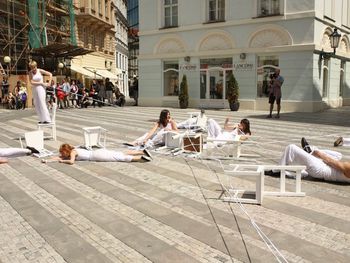Back
2015 » China » Section of Countries and Regions
| Curator: | Xinglin Liu |
| Designer / Architect of exhibition: | Zeen Tan |
| Institution: | China Institute of Scenography/China Center of OISTAT |
Fog or Not Fog
1) In one of his well-known poems, Chinese Tang-dynasty poet Bai Juyi wrote:
The bloom is not a bloom, the mist not mist,
At midnight she comes, and goes again at dawn.
She comes like a spring dream – how long will she stay?
She goes like morning cloud, without a trace.
The image of flower and fog is often employed in classical Chinese literary culture to imply the ephemerality of things / life. We chose this image to show our interpretation of the “Weather” theme for PQ'15, tinging it with Chinese aesthetics and perspectives.
2) The “Weather” theme for PQ'15 invites the participating countries and regions to explore the possible implications and inspiration that climate phenomena might offer to artists, and to (re)shape “the permeable borders of the accidental, the unknown and the mysterious.” For instance, fog may well be perceived as “a cloud that touches the ground,” while scenography may be understood as an art by which the imagined is made tangible for a (fleeting) moment.
Weather refers both to the climate of a given place and time, and to atmosphere of scenography created in space and through time. Scenography may work on our perception of space and time, just as changing weather does. “When we talk of weather we talk of atmosphere, of the ephemeral and the intangible, stability and instability – of balance, the rhythms and moods of the seasons, pressure and temperature, movement and transition, and perhaps, the unknown and unknowing, the unintentional and the accidental. When we talk of Scenography our vocabulary is not dissimilar.”
British scenographer Simon Banham, the curator of the “Weather” theme, believes that it is necessary to contemplate upon this theme from national and ethnic perspectives. The theme we propose for the countries and regions section, “Fog or Not Fog”, extends the main theme by adding to it, both literally and metaphorically, a perspective of Chinese culture.
3) The theme of “Weather” strongly coincides with the understanding of the changing world in traditional Chinese philosophy. As Lao Tzu stated in the Tao Te Ching:
Because the eye gazes but can catch no glimpse of it,
It is called elusive.
Because the ear listens but cannot hear it,
It is called the rarefied.
Because the hand feels for it but cannot find it,
It is called the infinitesimal.
These three, because they cannot be further scrutinized,
Blend into one.
Its rising brings no light;
Its sinking, no darkness.
Endless the series of things without name
On the way back to where there is nothing.
They are called shapeless shapes;
Forms without form;
Are called vague semblances.
He described a state that neither begins nor ends, that is ever changing yet is impossible to name, and that always returns to the intangible. In other words, it is a shapeless shape and form without form.
We may also read in his writing lines such as “a hurricane never lasts a whole morning, nor a rainstorm all day”, and “in Tao the only motion is returning; The only useful quality, weakness. For though all creatures under heaven are the products of Being, Being itself is the product of Not-being”, all pointing to the changing yet repeating cycling, like weather. We intend to reveal such qualities and the world view based on them through our theme, “Fog or Not Fog”.
4) Inspirations in the process of artistic creation come and go just like fog or changing weather. The moments are more often than not accidental and unpredictable. Only persistent, sharp-minded and sensitive artists may find and grasp such magical moments. Through our theme we hope to report and reflect these phenomenon and experience. We also try to call attention to historical, cultural and natural factors which, albeit invisible, have a profound effect on artistic creation.
5) Our theme is also about the temporal and elusive nature of theater performance, a nature that we need not avoid or overcome. Theater possesses the same beauty of elusiveness, unpredictability and ephemerality as fog. It is these aesthetic values that provide theater its raison d’être. And it is the artist’s mission to grasp and employ such moments that provide him with possibilities to intensify or amplify the world around us.
6) The functions and meanings of scenography must be carried out in combination with other factors in the process of performance, just as a climate is shaped by various weather conditions. Through our theme we intend to emphasize that scenography should remain open to all theater factors, including performers and audience, as well as other synthetic possibilities, or such factors which are yet to emerge.
7) Weather also refers to the stage directions or requirements found in many famous plays. There may be another interpretation, or another layer of interpretation, of the theme “Fog or Not Fog”. On the theatrical stage, fog, as well as wind, rain, snow and thunder is produced using technical devices. In other words, fog on stage is not fog in reality. The theater audience knows very well that it is only an imitation of the real world, even if a make-believe imitation. This is determined by the performer-audience relationship and the imaginative nature of the stage. After all, the stage is at most a parallel of the real world, rather than the real world itself.
Exhibiting artists / ateliers
[show all
| hide all]
- Zhengping Zhou
Zhejiang Province
Specialization: lighting designer
Participation in other important exhibitions: World Stage Design 2009 (WSD 2009)
Additional information: Lighting designer at the Zhejiang Institute of Art Research.
Exhibiting works
-
Renjie Wang (podle stejnojmenného díla spisovatele Tchang Sien-cu z Dynastie Ming/based on Ming Dynasty writer Tang Xianzu’s “Peony Pavilion”): (Kun Opera: The Peony Pavilion ),
(Beijing North Kun Opera Theatre ),
2014, Director: Qijing Cao, Chunlan Xu, scénický výtvarník/set designer: Xinglin Liu ; Identification of exhibit:
video ;
Comments: Lighting design for Peony Pavilion.
- Qiao Ji
Shanghai
Specialization: set designer
Education: Graduated from the Shanghai Theatre Academy
Collaboration with theatres: The Drama Art Center in Guangzhou
Participation in other important exhibitions: World Stage Design 2009 (WSD 2009)
Continuing collaboration with directors: Xinyi chen
Additional information: Research Institute of Art in Guangzhou, vice-president of the Chinese Institute of Scenography.
Exhibiting works
-
William Shakespeare: (Macbeth),
(Guangzhou Dramatic Arts Centre),
2014, Director: Xiaodi Wang, ; Identification of exhibit:
model , others ;
Comments: The stage design attempts to achieve concise and strong form and space, to express the performance’s atmosphere.
- Xinglin Liu
* 1953, Shanxi Province
Specialization: set designer
Education: Graduated from the Central Academy of Drama, Beijing
Collaboration with theatres: National Centre For Performing Arts In Beijing
Teaching activities: Central Academy of Drama since 1989
Participation in other important exhibitions: World Stage Design 2009 (WSD 2009) / World Stage Design 2013 (WSD2013).
Continuing collaboration with directors: Liuyi Li
Awards: Gold Award for Set Design at World Stage Design 2009 (WSD2009) / Shortlisted for Set Design Award, World Stage Design 2013 (WSD 2013).
Additional information: Currently a professor at the Central Academy of Drama in Beijing, Vice-president of the Chinese Institute of Scenography. Chairman of the China Centre of OISTAT.
Exhibiting works
-
Renjie Wang (podle stejnojmenného díla spisovatele Tchang Sien-cu z Dynastie Ming/based on Ming Dynasty writer Tang Xianzu’s “Peony Pavilion”): (Kun Opera: The Peony Pavilion ),
(Beijing North Kun Opera Theatre ),
2014, Director: Qijing Cao, Chunlan Xu, Liuyi Li ; Identification of exhibit:
model , others ;
Comments: Ming Dynasty writer Tang Xianzu’s Peony Pavilion is a famous classic Chinese play. The stage design
attempts to combine a contemporary visual style with the aesthetic principles of traditional Chinese opera.
-
Anton Chekhov: (The Cherry Orchard),
(Central Academy of Drama, Beijing),
2014, Director: Vladimir Sergeevich Petrov, ; Identification of exhibit:
model , others ;
Comments: Chekhov’s “The Cherry Orchard” is so familiar to us, in the passage of time, in the changes of society, that each and every one of us will feel irretrievably lost. This is my concept of stage design.
- Guangjian Gao
* 09.02.1961, Tianjin, China
Specialization: set designer
Collaboration with theatres: National Centre for the Performing Arts, Beijing
Participation in other important exhibitions: World Stage Design 2009 (WSD 2009)
Continuing collaboration with directors: Xinyi Chen
Additional information: Chief Inspector of Scenography at the National Centre for the Performing Arts, Beijing. Vice-president of the Chinese Institute of Scenography.
Exhibiting works
-
Fuchao Cai: (Beijing Opera: Throughout the Empire All Hearts Turned to Him),
(National Centre for the Performing Arts in Beijing / Beijing Opera Theatre),
2012, Director: Yimou Zhang, scénický výtvarník/stage designer: Guangjian Gao, světelný designér/lighting designer: Xin Xing ; Identification of exhibit:
model , others ;
Comments: The designer and the director try to use the principle of aesthetics, Chinese traditional art and traditional opera stage to create a new Beijing Opera style.
- Peiru Miao
Beijing
Specialization: set designer
Education: Graduated from the Central Academy of Drama in Beijing
Participation in other important exhibitions: World Stage Design 2009 (WSD 2009)
Additional information: Stage designer at the China National Theatre for Children, Beijing. Vice-president of the Chinese Institute of Scenography.
Exhibiting works
-
Chunqi Han: 太极传奇 (The Legend of Tai Chi ),
(Henan Song and Dance Company),
2013, Director: Weiya Chen, ; Identification of exhibit:
model , others ;
Comments: The stage design fully incorporated the characteristics and features of Chinese culture. The performance boasts a rich regional style.
- Sheng Han
Hebei Province
Specialization: set designer
Education: Graduated from the Shanghai Theatre Academy
Teaching activities: Professor at the Shanghai Theatre Institute
Participation in other important exhibitions: World Stage Design 2009 (WSD 2009)
Additional information: President and professor at the Shanghai Theatre Academy. Vice-president of the Chinese Institute of Scenography. Exhibited at PQ in 1987.
Exhibiting works
-
Li Li: 金缕曲 (Jin Song ),
(Shanghai Grand Theatre / Shanghai Jingju Campany),
2013, Director: Xiaoping Li, asistent scénického výtvarníka/co-stage designer: Yan-yan Yu ; Identification of exhibit:
model , others ;
Comments: Qing Dynasty writer Gu Zhenguan is the famous author of Jin Song. Gu, an intellectual working for the government, tries to rescue his friend Wu Zhaoqian. However, when Gu is finally reunited with Wu 20 years later, he is disappointed to find that Wu is not the same person any more and the two seem to be estranged.
- Wu Zhang
Participation in other important exhibitions: World Stage Design 2009 (WSD 2009)
Additional information: Stage designer at the National Theatre of China, Beijing.
Exhibiting works
-
Hua Yu: (To Live),
(National Theater of China),
2012, Director: Jinghui Meng, světelný designer/lighting designer: Qi Wang ; Identification of exhibit:
model , others ;
Comments: Adapted from the novel by renowned author Yu Hua, To Live is the latest production from China’s most influential theater director, Meng Jinghui. Touring many cities across China, it has claimed both critical recognition and box office success, becoming a sensation on the Chinese theater scene.
- Kedong Liu
Shandong Provence
Specialization: set designer
Participation in other important exhibitions: World Stage Design 2013 (WSD2013)
Additional information: Stage designer at the National Theatre of China, Beijing.
Exhibiting works
-
William Shakespeare: (Richard III),
(National Theater of China),
2012, Director: Xiaoying Wang, ; Identification of exhibit:
model , others ;
Comments: A performance of Shakespeare’s story with Chinese cultural elements.
- Qi Sang
Specialization: set designer
Additional information: Stage designer at the Shanghai Dramatic Arts Centre, Shanghai, China.
Exhibiting works
-
Albert Ramsdell Gurney: (Love Letters),
(Shanghai Dramatic Arts Center),
2014, Director: Huan Wang, ; Identification of exhibit:
model , others ;
Comments: A love story about a man and a woman who communicate with each other over fifty years.






















